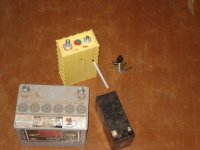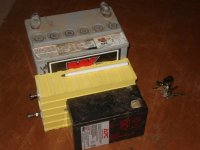crimsonsnake0
10 W
- Joined
- Aug 2, 2010
- Messages
- 68
hi anyone know where i can buy a battery meter reading thingy for 72v? can only find them up to 60v cheers
crimsonsnake0 said:hi anyone know where i can buy a battery meter reading thingy for 72v? can only find them up to 60v cheers
itchynackers said:Here's a stupid question...can I split the voltage somehow? I.E. run two turnigy meters, each with half the voltage running to them, then join back up the voltage afterward?
Jeremy Harris said:Zenid,
Although your LED meter is probably vaguely OK for monitoring the very approximate state of charge of an SLA battery pack, it would be pretty useless for trying to determine anything useful about the state of charge of either of the two types of lithium battery that the vast majority of ES forum members are using. Both LiPo and LiFePO4 cells have a virtually flat voltage vs charge state characteristic, so a voltmeter would read pretty much the same right up until the point where the cell voltage collapses very quickly at full discharge. It's for this reason that the majority of us are using proper power meters, that measure true power taken from the battery, both in watt hours and amp hours. These give a pretty foolproof way of monitoring consumption, provided you know your battery pack usable capacity and that it pack was fully charged at the start of the monitoring period. For voltages less than 60V these things are cheap - just $24 for the Turnigy one from HK.
Jeremy
Jeremy Harris said:Very few people are still using SLA packs on ebikes AFAIK; they are very rarely discussed on here now that the various lithium cells have become so affordable in terms of lifetime cost.
Jeremy Harris said:Finally, I made a homebrew wattmeter/battery charge state indicator that would work at any voltage and current and the cost of the parts was probably only about $45 or so. It's pictured on this post: http://endless-sphere.com/forums/viewtopic.php?f=2&t=14498#p219880
Zenid said:Please excuse my unfamiliarity with the layout of the forum, - I only joined a few hours ago. I assumed the term "e-bikes" also referred to scooters (though I see there is a dedicated scooter section further down), where Lithium ion batteries are definitely NOT the norm, as far as I am aware. 12V 28AH Li batteries of the type that could be used by my scooter/'motorbike' and others like it are prohibitively expensive, and I and other owners are frustrated with the lack of affordable Lithium ion batteries that could replace the lead bricks we have to use.
If I am wrong, here, then I am absolutely dying to be corrected on this point. Nothing would make me happier than hearing about a Lithium pack I could use on my scooter that doesn't cost over twice the value of the whole bike.
Jeremy Harris said:I assume that you're now running a 72V nominal, 28Ah notional capacity, lead acid set up at the moment. This has a theoretical capacity of around 2000 Wh and a usable capacity of maybe 1600 Wh under ideal conditions (probably less, due to the high Peukert factor for LA cells).
Jeremy Harris said:A direct replacement for your present battery pack might be either a 24S LiFePO4 pack (77V nominal) or maybe a 20S LiPo pack (74V nominal). For the same usable capacity you would want around 22Ah of either lithium cells. A 20S, 5P pack of 5Ah, 15C LiPo (which would give you around 24 to 25 Ah of usable capacity at about 74V) would cost you around $800 plus shipping and taxes, and you would need a to buy a suitable charging system, and, perhaps, some form of low voltage warning.
If you were to opt for LiFePO4, then the best buy at the moment are probably Headway cells. These are around $19 each for 10Ah cells, and, to ensure that you have at least as much power as you have now (in fact around 20 to 25% more) you would really need a 24S, 3P pack (76V, 30Ah). This would cost around $1400 plus shipping, taxes, etc, and again you would need a new charging system and, ideally, a battery management system.
Maybe this is way too expensive, but given that the lithium cells (particularly LiFePO4) may last at least twice, maybe three or four times, as long as sealed lead acid, plus give a big weight reduction and better voltage stability, they are well worth looking at.
Jeremy
It will also change the handling of the vehicle, probably for the better, but keep it in mind.Zenid said:Simply losing this weight should add substantially to the power I get in practical terms.
Well, SLAs don't generally take a very high charge current, usually something on the order of 1/4C at most. For yours, that would be about 7A, which isn't much in the realm of regen from higher speeds--you could get a lot higher currents than that initially. The SLA might take that ok, if it's infrequent and very short duration.One other highly pertinent issue is the matter of regenerative braking. The controller I'm about to get will have this, but presumably it is set up for SLAs, and I have no idea of the implications of this for dealing with a Lithium battery bank.
Theoretically, any BMS you have for them would be what deals with that. But the controller should have some control over the regen voltage and/or current output limits, although it might be via component values (changing resistors/etc.) rather than via programmed parameters.Controllers can be programmed to alter various parameters, but I have no idea if the recharging circuit can be set up for these batteries.
Jeremy Harris said:A direct replacement for your present battery pack might be either a 24S LiFePO4 pack (77V nominal) or maybe a 20S LiPo pack (74V nominal)
{...}
Jeremy Harris said:The battery fire scaremongering has really done lithium an unfair disservice. Virtually every mobile phone and laptop in the world is running on LiPo, as are a few tens of thousands of power tools and model aircraft, yet you don't hear of these bursting into flames [...]
20S would be 20 series cells, typically 3.6-3.7V per cell. 5P is 5 parallel strings of those cells. At 5Ah per cell that means 25Ah. At 15C current draw capability, that means 15 x 25 for the Amps you could draw at any time.Zenid said:Does the"20S, 5P pack of 5Ah, 15C LiPo" (74V nominal) offer a capacity and power close to what I have now, and can I draw as much amperage?
It's not calculated like that. it's not 20 x 5Ah, because 20 is how many are in series, which is multiplied by volts, not Ah. So to find Ah of the pack, you multiply by how many are in parallel, which is 5; that gives you 25Ah.On the face of it the pack you describe - 20 x 5AH (100AH combined) would look lower capacity than my 6 x 28AH (168 combined AH). What am I missing?
Also I'm confused about "24S, 3P pack (76V, 30Ah)": This would be 24 cells right? 30AH per cell would be huge, again am I missing something?
I'm sure it's possible for lots of things to happen depending on the cell construction and chemistry. But these days, many cells appear to be made to prevent this.Zenid said:Thanks for the reassurance on that point. I just happened upon a link covering a littany of horror stories, including alleged incidents where even a dog bite caused a cell to catch fire.
Depends on the chemistry. There are some flat-type (pouch) cells that Cell_man here on ES was selling (he ran out) that were 20Ah capacity, but not very large.Zenid said:30AH per cell would be huge, again am I missing something?


